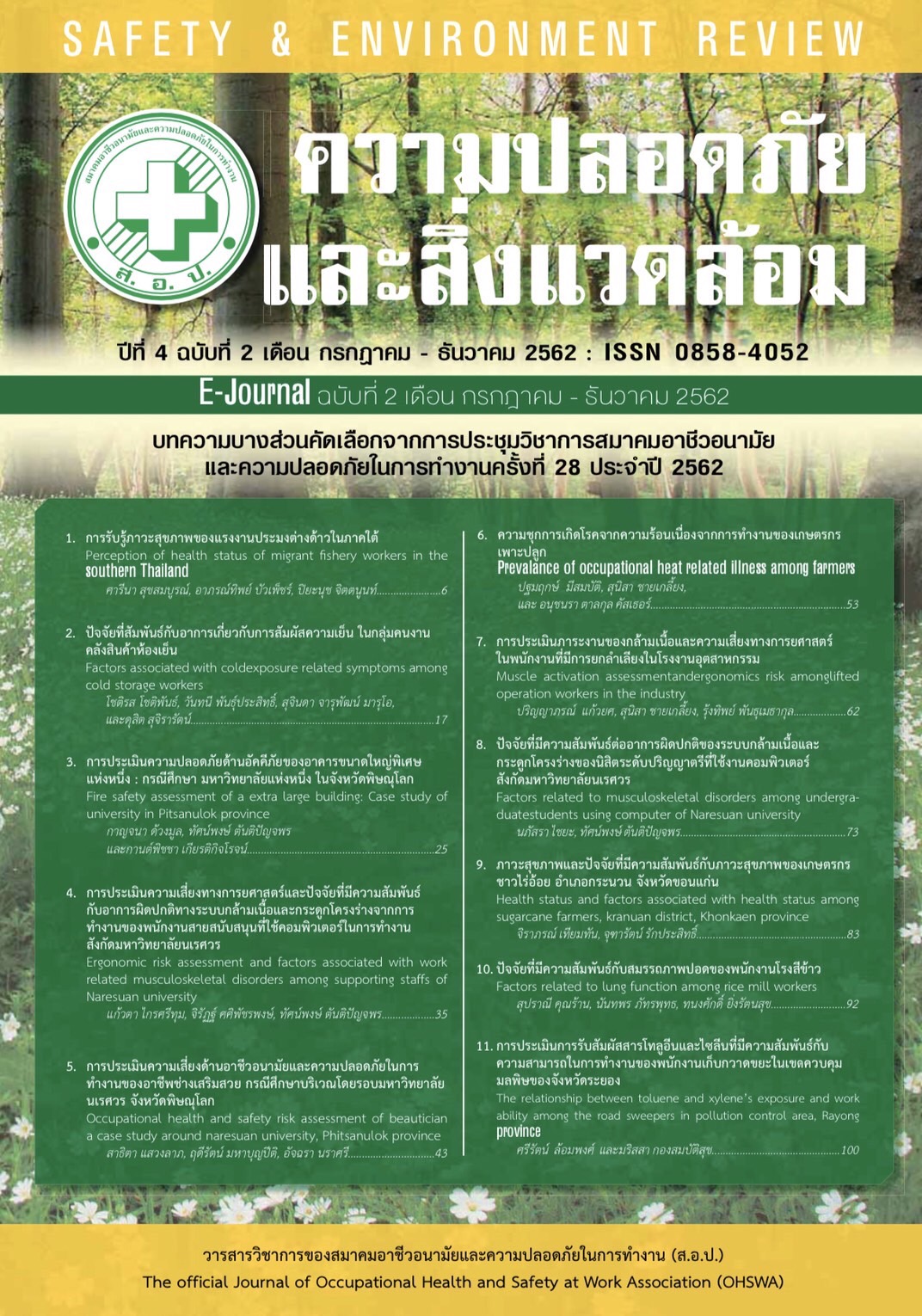The relationship between toluene and xylene’s exposure and work ability among the road sweepers in pollution control area, Rayong Province
Keywords:
Toluene, Xylene, Work ability, Road sweeperAbstract
This research was a cross sectional study. The objectives were to evaluate toluene and xylene’s exposure and work ability
among the road sweepers in pollution control area in Rayong province. We sampled 200 persons. The mean age of the study group (n=100) was 44.05 years; the mean age in the comparison group (n=100) was 33.95 years. Ninety two percent of the study group worked 8 hours per day; 63 % worked, 6 days per week. Fifty seven percent always used respiratory protection; however, most of them used only cotton masks (97.9%). Most of them about work ability had good level (64.0%). In order to assess exposure to pollutants air sample were collected by attaching a personal “Organic Vapor Monitor (3M 3500)” to the lapel of each participant. Results of the study group (n=100) showed average exposure measures of toluene of 86.09 (SD= ± 84.016 ppb) and xylene 4.85 (SD= ± 6.125 ppb). Urine samples were also collected after the work shift. Results of urine samples (n=100) showed average + SD of toluene to be 0.001 ± 0.002 μg/l and xylene 0.038 ± 0.082 μg/l. The average comparison of concentration of toluene and xylene was significantly different between the study and comparison groups at level 0.05 (p <0.001 and p<0.001, respectively). However, the relationship between toluene and xylene in atmosphere and in urine and work ability of study group were not significant. We should be concerned about the training in order to gain the knowledge and understanding the hazard environment in working place and the protection. Furthermore, road sweepers should be advised to use suitable respiration protective equipment in a correct manner.
References
วชร โอนพรัตน์วิบูลและอดุลย์ บัณฑุกุล. สารตัวทำละลายอินทรีย์. ตำราอาชีวเวชศาสตร์ text books of occupational medicine. กรุงเทพมหานคร: โรงพยาบาลนพรัตนราชธานี กรมการแพทย์ กระทรวงสาธารณสุข. 2554.
Dennison JE, Bigelow PL, Mumtaz MM, Anderson ME, Dobrev ID, Yang RS. Evaluation of potential toxicity from co-exposure to three CNS depressants (toluene, ethylbenzene and xylene) under resting and working conditions using PBPK. J Occup Environ Hyg 2005; 2(3): 127- 35.
Chang FK, Chen ML, Cheng SF, Shih TS, Mao IF. Dermal absorption of solvents as a major source of exposure among shipyard spray painters. J Occup Environ Med 2007; 49: 430-6.
ศรีรัตน์ ล้อมพงศ์. การประเมินผลกระทบต่อสุขภาพจากการสัมผัสสาร Organic Solvent ในกลุ่มปฏิบัติงานกับรถโดยสารธรรมดา. คณะสาธารณสุขศาสตร์ มหาวิทยาลัยบูรพา. 2553.
Jimenez GO, Marquez GS, Albores A, Caudillo CC, Carrieri M, Bartolucci GB, Manno M. CYP2E1 phenotype in Mexican workers occupationally exposed to low levels of toluene. Toxicol Lett 2012; 210 (2): 254 – 63.
Ongwandee M, Chavalparit O. Commuter exposure to BTEX in public transportation modes in Bangkok, Thailand. J Environ Sci (China) 2010; 22 (3): 397 – 404.
อรวรรณ แก้วบุญชู. คู่มือประเมินความสามารถในการทำงาน. ภาควิชาการพยาบาลสาธารณสุข คณะสาธารณสุขศาสตร์ มหาวิทยาลัยมหิดล. 2550.
บุญธรรม กิจปรีดาบริสุทธิ์. ระเบียบวิธีการวิจัยทางสังคม. พิมพ์ครั้งที่ 10. กรุงเทพมหานคร: จามจุรีโปรดักส์; 2551.
ACGIH. Threshold limit values for the chemical substances and physical agents and biological exposure indicies. American Conference of Governmental Industrial Hygienists, Cincinnati, Ohio, USA. 2011.
Martinez, M.C, & Latorre, MRDO. Health and work ability among office workers. Rev Saude Publica 2006; 40(5):1-7.
Tuomi, K., Huuhtanen, P., Nykyri, E. & Ilmarinen, J. Promotion of work ability, the quality of work and retirement. Occup Med 2001; 51(5):318-24.
Pohjonen, T. Perceived work ability of home care workers in relation to individual and work-related factors in different age groups. Occup med 2001;51(3):209-17.
Kiss, P., Walgraeve, M. & Vanhoorne, M. Assessment of work ability in aging fire fighters by means of the work ability index preliminary results. Arch Public health 2002; 60: 233-43.
Monteiro, MS., Ilmarinen, J., Corraa Filho, HR. Work ability of workers in different age groups in a public health institution in Brazil. Int J Occup Saf Ergon 2006; 12:417-27.
อรวรรณ แก้วบุญชู. ปัจจัยที่เกี่ยวข้องกับสุขภาพของผู้ใช้แรงงาน. ในเอกสารประกอบการอบรมระยะสั้น เรื่องการพยาบาลอาชีวอนามัย. หน้า 31 – 40. ภาควิชาการพยาบาลสาธารณสุข คณะสาธารณสุขศาสตร์ มหาวิทยาลัยมหิดล. 2546.
Mandiracioglu A, Akgur S, Kocabiyik N, Sener U. Evaluation of neuropsychological symptoms and exposure to benzene, toluene and xylene among two different furniture worker groups in lzmir. Toxico Ind Health 2011; 27(9): 802-9.
Wanna Laowagul, Kunio Yoshizumi, Auemphorn Mutchimwong, Patana Thavipoke, Martin Hooper, Hathairatana Garivait, Wongpun Limpaseni. Characterisation of ambient benzene, toluene, ethylbenzene and m-, p- and o-xylene in an urban traffic area in Bangkok, Thailand. International Journal of Environment and Pollution 2009; 36: 241-54.
Ciarrocca M, Tomei G, Fiaschetti M, Caciari T, Cetica T, Cetica C, Andreozzi G, Capozzella A, Schifano MP, Andre JC, Tomei F, Sancini A. Assessment of occupational exposure to benzene, toluene and xylenes in urban and rural female workers. Chemosphere 2012; 87 (7): 813-9.
Chen ML, Chen SH, Guo BR, Mao IF. Relationship between environmental exposures to toluene, xylene and ethylbenzene and the expired breath concentrations for gasoline service workers. J Environ Monit 2002; 4(4): 562-6.
Downloads
Published
Issue
Section
License

This work is licensed under a Creative Commons Attribution-NonCommercial-NoDerivatives 4.0 International License.


